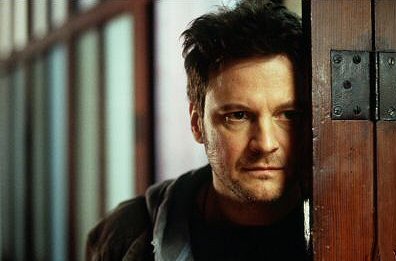Firth's madness
Colin Firth's new movie
sees him going mad in the East End of London. Our critic discovers why
|

|
It is summer 2003 and
Colin Firth is acting mad in a disused hospital in Homerton, a rundown
area of East London. The star of Pride
and Prejudice and Girl With a
Pearl Earring is playing Ben—a recently widowed, troubled artist—in
Trauma, a horror film
that sees the much-desired 43-year-old actor shed his image in favour
of an altogether more daring, more experimental, project.
“We developed a picture of Ben which is partly to do with Colin’s own
life,” explains the director of Trauma,
Marc Evans. “In a way, if he wasn’t Colin Firth the actor, the
character of Ben is quite similar to his own earlier experiences. A lot
of Colin’s mates were like Ben. They lived in the East End, a lot of
them were ex-art college or ex-drama school. So we tapped into that
vibe—the feeling of isolation we both felt when we were younger and
coming to London to live for the first time.”
Firth’s own journey to London, in the 1980s, was from Hampshire. Evans,
meanwhile, is a Welshman who is best known for making My Little Eye, a low-budget horror
movie that was a minor hit in 2002.
Evans made this earlier, chilling film in America with a group of young
American actors. It’s the story of a group of college students who live
together in a large, remote house, competing over six months to win a
reality TV show. Evoking both The
Blair Witch Project and Big
Brother, the film slowly develops into a violent bloodbath.
Back among the Victorian streets and dilapidated buildings of East
London, Trauma is an attempt
by Evans to inject some life into the British horror film on his home
turf.
It’s a genre tackled only occasionally and with little confidence by
British film-makers. In 2002 Danny Boyle resurrected the zombie story
for 28 Days Later (to huge
success in America). This year the team behind the cult TV series Spaced took a tongue-in-cheek
sideswipe at the idea of London being overrun by the possessed in Shaun of the Dead But that was
essentially a comic spoof. Trauma
is horror with a brain, an attempt to realise the horror movie’s
potential to delve into its characters’ psychological turmoil and to
express something about the real world without resorting to excessive
gore or know-it-all irony.
It’s essentially a character study of Ben and his fragile grief in the
days after his wife Elisa (Naomie Harris) dies in a car crash that
leaves him in a coma. When he wakes, he is virtually alone in a city
that appears threatening and frightening. Furthermore, he awakes to the
newspapers and television mourning the death, an apparent murder, of a
well-known pop star, played by Alison David.
Slowly the lines blur between fact and fiction. Is Ben actually
involved in this murder? Is his wife really dead? The film toys with
ideas of mental illness, truth, reality and alienation in the city. It
has a fractured narrative, which reflects Ben’s own disturbed mind, and
only slowly reveals itself for what it is: a psychological horror
story—with a twist. It demands much concentration from audiences.
“It was a risky film in that sense,” Evans says. “There’s a fine line
between ambiguity and confusion, between being intrigued and being
frustrated, and I don’t think anybody knows exactly where that line
lies. I wanted to make a film that visually and syntactically reflected
what it was like to be Ben. What I’m scared of more than anything is
trying too hard, though, as opposed to the film having a tumbling story
style, which is what I was aiming for.”
Evans’s depiction of London is harsh and uncompromising. Not for this
director the obligatory shot of a red double-decker bus every five
minutes. He uses the railway arches, back alleys and empty buildings of
East London to great effect.
“It’s quite a gothic story,” Evans explains, “and I thought I would tap
into the gothic thing. Also, everybody, whether they live in London or
they are an immigrant like me, still has a massive relationship with
the place. You want to have a crack at doing a London story.”
The city becomes a terrifying place for Ben, and Evans invites us to
share that terror. He got the cinematographer John Mathieson (Love is the Devil) to employ a
warped, almost hallucinogenic, impression of Ben’s dark thoughts. One
outdoor shot of a breaker’s yard with the tower of Canary Wharf
flashing in the half-light in the background is particularly haunting.
“London’s a real jungle for people in that condition,” Evans says. “I
liked the idea of the East End as a kind of hinterland, and Canary
Wharf and its corporate uncaring image seemed appropriate to this film.
The area had spooky potential, too, with the sounds of trains on the
railway bridges.”
Between making My Little Eye
and Trauma, Evans returned to
his roots to make a documentary about Welsh language poetry for which
he employed the talents of the actor Rhys Ifans, the singer Cerys
Williams (formerly of the band Catatonia), John Cale (of the Velvet
Underground) and several other Welsh “usual suspects”, as he puts it.
Now he’s planning to make a biopic of the Welsh record producer Joe
Meek—to be played, Evans hopes, by Ifans—and a teen movie set in a
Swansea high school in 1976.
Firth, meanwhile, will next be seen in Bridget Jones: the Edge of Reason,
the film he made straight after Trauma.
Some things, it seems, never entirely change.
Trauma opens on Sept 17.
|
